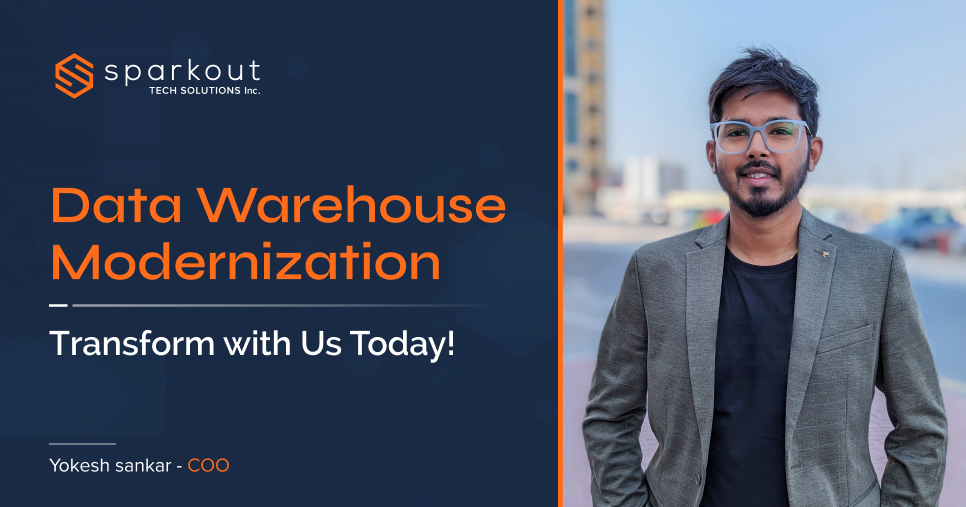Do you know? By the end of next year, 2025, it is expected that the global data size can increase upto 181 zettabytes. That is 181 followed by 21 0’s bytes.
Another fact is that, according to Rivery’s analysis reveals that a staggering 90% of the world’s data was created in just the past two years, with stored data doubling approximately every four years.
So, data is undeniably getting bigger and has become an important asset in the business world.
This means that every business needs to find a scalable, reliable, and faster way to accommodate and process the mind-boggling volume of data. And also the need to address the elephant in the room, real-time data analysis.
The solution? Data Warehouse Modernization.
In the upcoming sections, we will talk about how important data warehouse modernization is for a business, its architecture, and how it can solve the inability of its predecessor, the traditional data warehouse.
Feel free to jump to any section to learn more about how to modernize the data warehouse!
The Growing Data Challenge – Why Traditional Data Warehouses Aren't Enough
Data is getting bigger and unstructured daily. Traditional Data warehouses typically excel in structured data and even perform traditional data analysis, but they struggle to accommodate the diverse format and the source of unstructured information.
Nearly 43% of IT decision-makers worldwide are concerned that their existing infrastructure won't be equipped to handle future data demands.
It can take a significant amount of resources to scale the existing traditional data warehouse and even if the business is ready to partake, there is a high probability of performance bottlenecks and analysis capabilities.
Moreover, the data quality and the security pose as one of the major challenges that traditional data warehouses may not be equipped enough to deal with.
The next evolution of the data warehouse is no longer optional; it’s a necessity.
But, What is Data Warehouse Modernization?
Data warehouse modernization refers to improving and changing how the traditional data warehouse is built to solve today’s data issues as well as modern businesses. This is done by means of a radical revision of the architecture itself, shifting from on-premise systems to much more flexible, scalable, and cloud computing systems.
Key Difference Between Traditional and Modern Data Warehouse
| Differentiation Factor | Traditional Data Warehouse | Modern Data Warehouse |
|---|---|---|
| Infrastructure | On-premise servers and hardware | Cloud-based, flexible, scalable |
| Data Processing | Batch processing, periodic updates | Real-time or near-real-time processing |
| Scalability | Manual, hardware-dependent | Automatic, cloud-enabled scalability |
| Data Model | Rigid, fixed schemas | Flexible, dynamic schemas |
| Data Integration | Slow ETL process | Fast ELT, seamless integration |
| Analytics | Limited to historical data | Advanced analytics, AI integration |
| Maintenance | Ongoing manual updates and maintenance | Managed by the cloud provider, with minimal downtime |
| Cost | High upfront costs for infrastructure | Pay-as-you-go pricing |
How Data Warehouse Modernization Works – Key Components
Before knowing the key components of a Modern data warehouse (MDW), it is important to understand a couple of terminologies, data lakes, and schema.
Data lakes and data warehouses may both store data, but they serve completely different purposes. Think of a data lake as a massive storage pool where all kinds of data—raw, and unstructured can flow in freely. In contrast, a data warehouse is more like a well-organized library, holding cleaned, structured data that's ready for analysis.
Another important element to consider is the schema. Simply put, a schema is like a blueprint that explains how your data is organized, stored, and connected. In data warehouses, schemas are essential for keeping everything in order and making sure data can be accessed quickly and efficiently when you need it.
There are a handful of schemas such as stars, snowflakes, facts, and galaxies and it varies depending on the business requirement and data models.

The next evolution of the data warehouse is no longer optional; it’s a necessity.
MDW works with four major stages:
- Stage #1 – Ingest – Data from various sources is ingested and persisted (stored) in a data lake.
- Stage #2 – Transform – Data validation and transformation to a schema.
- Stage #3 – Data Modeling – Optimizing data for consumption.
- Stage #4 – Serve – Data is exposed with visualization and analysis for the end user.
Key Components are:
- Storage – Storing all raw data from diverse sources, commonly data lakes.
- Compute – Framework for managing to ingest, transform, and serve.
- Orchestrator – Ensures seamless end-to-end coordination and automation of the entire data pipeline, managing workflows and dependencies efficiently.
- Security – Application, platform, and data security.
- Data governance – Guarantees that datasets are managed and organized alongside their recorded lineage.
- Operation (DevOps) – Effective management of the data system, encompassing CI/CD, automated testing, and oversight.
Benefits of Data Warehouse Modernization
Faster Data Access
Modernized warehouses allow quicker data retrieval, empowering real-time decision-making.
Scalability
Cloud-based solutions scale easily to handle growing data volumes without significant infrastructure costs.
Cost Savings
Reduces infrastructure and maintenance costs through cloud storage and pay-as-you-go models.
Improved Data Quality
Enhances data accuracy through automated cleaning and governance tools.
Better Collaboration
Encourages teamwork across departments by providing centralized data for shared insights.
Simplified Maintenance
Reduces manual updates and system checks with automated features and cloud management.
Stronger Security
Provides built-in encryption and compliance with regulations for better data protection.
Fosters Innovation
Helps create new business models and drive innovation through easy access to valuable data insights.
- Faster Data Access – Modernized warehouses allow quicker data retrieval, empowering real-time decision-making.
- Scalability – Cloud-based solutions scale easily to handle growing data volumes without significant infrastructure costs.
- Cost Savings – Reduces infrastructure and maintenance costs through cloud storage and pay-as-you-go models.
- Improved Data Quality – Enhances data accuracy through automated cleaning and governance tools.
- Better Collaboration – Encourages teamwork across departments by providing centralized data for shared insights.
- Simplified Maintenance – Reduces manual updates and system checks with automated features and cloud management.
- Stronger Security – Provides built-in encryption and compliance with regulations for better data protection.
- Fosters Innovation – Helps create new business models and drive innovation through easy access to valuable data insights.
Addressing the Need for Real-Time Data Analysis – Overcoming Traditional Data Warehouse Limitations
| Key Features of Data Warehouse Modernization | How it enables real-time data analysis |
|---|---|
| Cloud-Based Architecture | Provides instant data access and allows continuous data processing with minimal delay. |
| Real-Time Data Ingestion | Enables continuous data flow through streaming and change data capture (CDC), eliminating batch delays. |
| Distributed Computing Power | Allows parallel data processing across multiple servers, ensuring fast analysis even for large datasets. |
| In-Memory Computing | Stores data in RAM for faster access and computation, enabling quicker real-time analysis and decision-making. |
| Data Integration from Multiple Sources | Integrates data from IoT, social media, APIs, and more, providing a comprehensive view for immediate analysis. |
| Automated Data Processing & Analytics | Automates data processing and analysis using machine learning, providing instant insights. |
| Faster Query Performance | Utilizes query optimization (e.g., columnar storage, indexing) to retrieve and analyze data in seconds. |
| Real-Time Dashboards & Reporting | Updates dashboards in real-time, enabling stakeholders to monitor performance and trends as they happen. |
| Enhanced Data Security | Ensures data security and compliance with encryption, access controls, and real-time monitoring during data ingestion and analysis. |
| Scalability | Scales dynamically to handle increasing data volumes, maintaining performance even during peak data loads. |
Related Reads:
A Simple Roadmap to Modernize Your Data Warehouse
Modernizing a data warehouse can be difficult and tedious, but by collaborating with a data warehouse modernization services provider, businesses can simplify the process. Here’s how you can approach it:
Assess Your Current Setup
- Collaborate with experts to identify performance gaps, scalability issues, and data integration challenges.
- Get an external perspective on how your existing data architecture aligns with modern business needs.
Define Modernization Goals
- Work with the service provider’s team to clarify your objectives:
- Real-time data processing.
- Cost-efficient scalability.
- Integration with advanced tools like AI/ML.
Select the Right Partner
- Choose a service provider with expertise in cloud-based platforms.
- Look for experience in handling real-time data processing, migration, and analytics.
Run a Pilot Project
- Allow the modernization team to execute a small-scale proof of concept.
- Evaluate their performance and the initial results before scaling up.
Phased Migration
- Delegate the phased transition of data and processes to experts for a seamless modernization experience.
- Ensure your partner runs hybrid systems (traditional and modern) during migration to minimize disruptions.
Implement Real-Time Analytics
- Leverage service providers’ tools and expertise to enable real-time data ingestion and processing.
- Gain instant business insights through integrated dashboards and reporting tools.
Optimize and Monitor
- Rely on the service provider to fine-tune your new system for performance, cost efficiency, and scalability.
- Conduct regular system health checks and updates.
Team Enablement
- Ask the service provider to train your internal teams on the new platform.
- Ensure your employees can independently handle data-driven decision-making.
Track and Evaluate Success
- Collaborate with your service provider to measure ROI, query performance, and business impact.
- Use these insights to refine the system further.
Data Warehouse Modernization – Present and The Future
This growth of data shows no signs of slowing down and companies that don't adopt it risk falling behind.
Traditional data warehouses serve as a foundation but can't meet the needs for instant analysis, growth potential, and budget-friendly options in today's fast-moving world.
Updating the data warehouse isn't just about new tech; it's about making your business ready for what's next. By using cloud systems, instant data handling, and AI-powered insights, updated data warehouses help companies make smarter, quicker, and better-informed choices.
Modern data warehouses open doors to new ideas creating fresh chances for businesses to succeed in the digital age as the core of data-driven change.
Embracing these updates isn't a choice; it's a must to stay in the game, be flexible, and be prepared for what's coming.
Are you set to step into the future of data handling? Collaborate with a data warehouse modernization services provider to update your data warehouse now and change how your business uses data to succeed.
Frequently Asked Questions
A data warehouse is OLAP. It supports analytical tasks like reporting and trend analysis, unlike OLTP, which handles day-to-day transactional data.
- Star Schema – Simple and efficient for reporting.
- Snowflake Schema – Handles complex queries.
- Cloud-Based – Ideal for scalability and real-time analytics.
- Data Integration – Merging data from multiple sources.
- Scalability – Managing growing data volumes.
- Costs – Building and maintaining infrastructure.

CO-Founder
Yokesh Sankar, Co-Founder and Chief Operating Officer of Sparkout Tech Solutions, leverages his expertise to drive innovation and operational excellence in the software industry. Passionate about empowering individuals with essential skills, he uses technology to streamline business processes and enhance efficiency. He advocates for AI and blockchain adoption, helping businesses integrate these technologies seamlessly into their operations. Staying ahead of AI trends, Yokesh explores industry applications and shares insights to foster growth and knowledge in the tech sector.